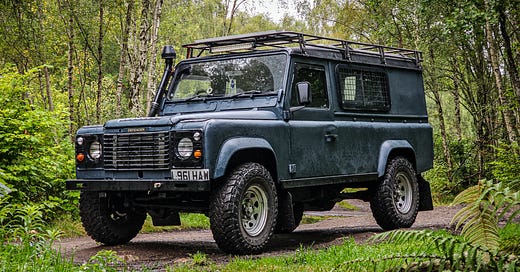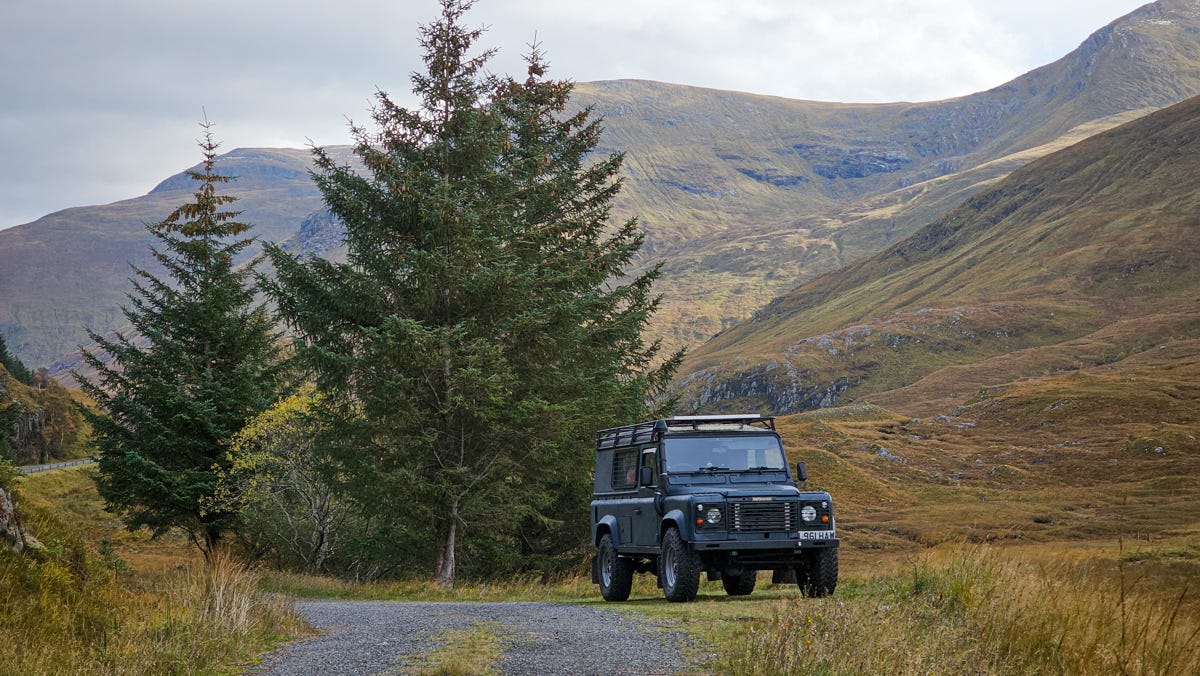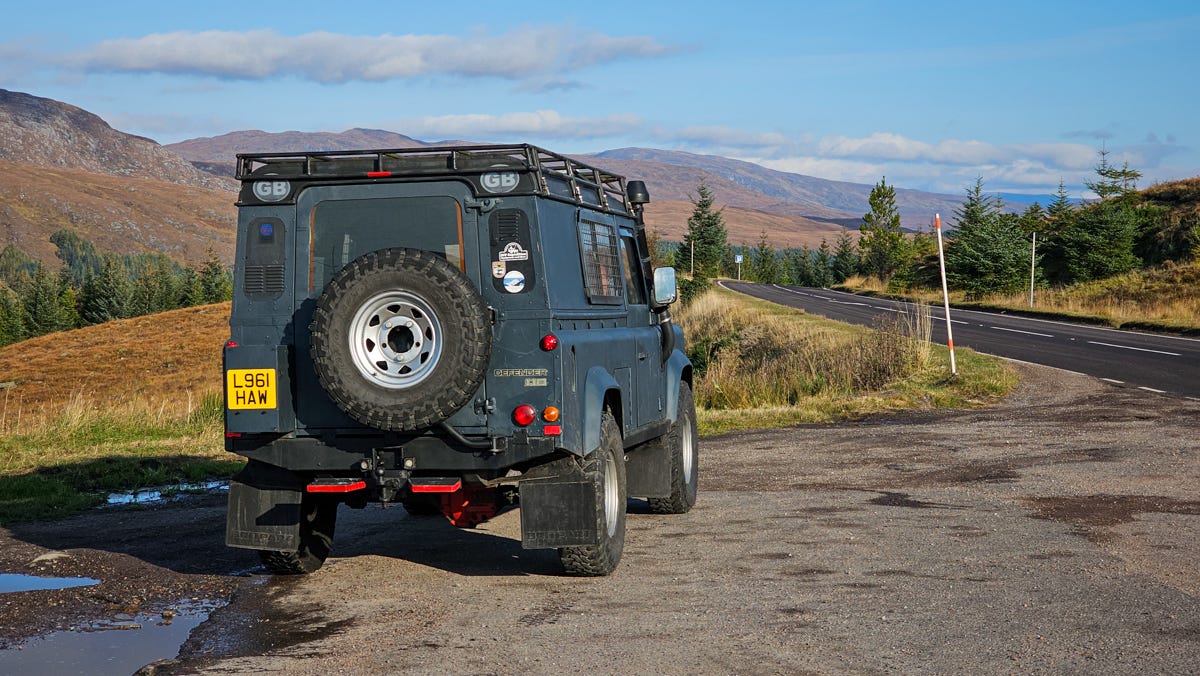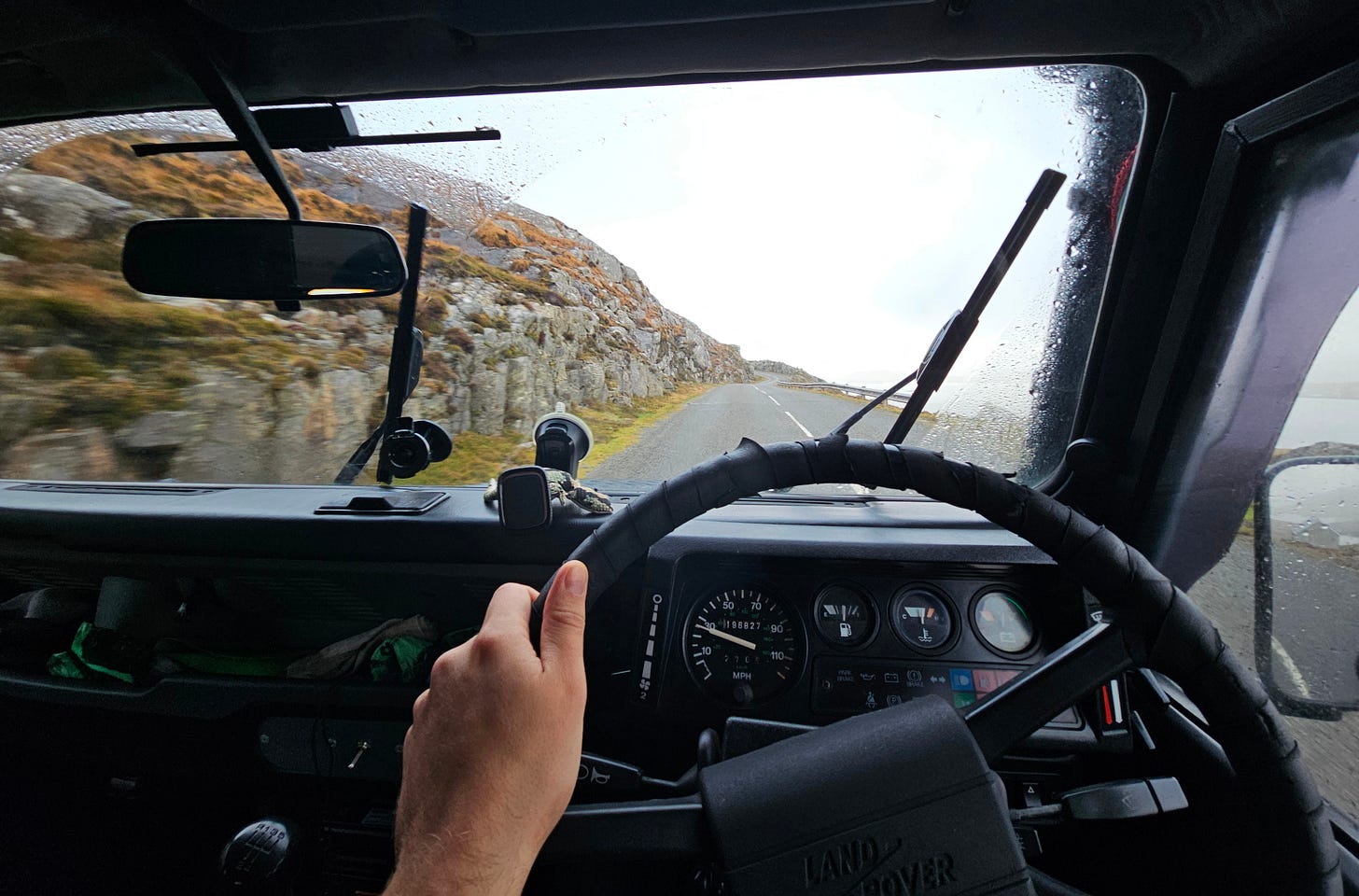Because my words here tend to involve maps and solitude and aspirations, I thought I’d introduce you to the Defender which will power my wandering for the foreseeable future.
My 10-week European journey to Greece last year involved about 50 nights sleeping in the back of an unmodified £4000 Range Rover. Piloting that burbly great wafter was a supremely cushy experience, but I returned to the UK with the nagging feeling that my ideal long-distance Land Rover needs to be more of a camper that a car.
The thing is, travelling by road isn’t the same as living on the road.
The case for buying a Defender
If every minute you spend behind the wheel is a minute wasted, and your life is on hold until you reach your destination, your vehicle is simply a means of conveyance, so it makes sense to be driving fast and comfortable. But if you have the incredible privilege of being able to take your work with you and therefore have a more flexible agenda, you need a vehicle you can live in and around. That means you want to be able to cook, eat and work from it, in any weather, and sit somewhere other than the driver’s seat. If it can take you off into the mountains or enable you to wake up on a beach, so much the better.
A long-wheelbase Defender is probably the smallest vehicle you can realistically do this in. The rear loadspace is 6ft long, and there’s just enough headroom to kneel in. It also happens to have all the rugged continent-crossing capability you could want. And it’s depreciation-proof. And you can fix it with a hammer.
And it’s just... cool. (I think so anyway.)
You may not know this, but there are such people as “Land Rover people” who grew up thinking about little other than the Land Rovers they would one day rescue and mend and build and disappear in, and who now – as adults with a string of oily disasters and triumphs and exasperated partners behind them and boxes of salvaged components in the shed – could never envisage life without some kind of Land Rover. We’re a quiet network, known to each other, living among you and pretending we’re okay with the modern world.
The object of my affections
Gandalf is an ex-military Land Rover Defender 110 dating from 1992, and rebuilt around a decade ago by a previous owner who kept everything pleasingly old-school. The engine is a remanufactured 300Tdi which means it’s from a slightly later ’90s Land Rover, but the LT77 five-speed manual gearbox is original spec. Good and clunky it is too. The vehicle’s most complicated component is its stereo, and that’s just the way I like it (aha, aha).
Because it’s a Defender, you get permanent four-wheel drive, a low-range transfer box with a lockable centre differential, coil-sprung beam axles front and rear, power steering… and other amenities such as wheels and bodywork.
This one has a few toys too. The raised air intake means the engine won’t inhale H2O during river crossings, and desert dust is less likely to clog the air filter – not that I’ve found any deserts here in Scotland yet. The rear axle has a limited-slip differential which helps to portion torque evenly across the axle if one of its wheels starts spinning so you’re less likely to get stuck, and the intercooler is an aftermarket upgrade, enabling a tad more efficiency by feeding cooler (and therefore denser) air into the engine.
But Gandalf is far from perfect. For one thing, the gearbox’s synchromeshes are toast, so plenty of double-clutching is called for – and if you don’t know what that is, you’re probably the kind of yellow-livered, honey-dipped milkflower that wouldn’t feel at home behind the wheel. Only kidding... (or am I?) The upshot of the knackered synchros is that you have a dip the clutch twice between most gear changes and match the engine speed to the gearbox with a blip of the throttle before slotting it into the new gear, gauging it using your ears rather than a rev counter – because there isn’t one. Hard work, but satisfying in its way, and it occupies less mental bandwidth the more you do it.
These old Land Rovers are much narrower than most modern vehicles. The overall dimensions didn’t really change from 1958 to 2016. The huge benefit of this is you can park them anywhere and squeeze between any gateposts you find. Compact, I call it. The downside is that you have to be cunning with your use of storage space. Speaking of which...
A roof rack should be a last resort, although I’m quite satisfied with the build quality of this one (anyone recognise the brand? I don’t) and I will have stuff to keep up there on Gandalf’s upcoming voyage, so it’s staying put for now. I would however like to evolve the setup to the point where I can do without it one day.
I’ll do this by introducing more storage, lower down. Defenders have a lot of unused space between the chassis and the body, so there are plenty of aftermarket storage lockers and tanks available to make use of it all. This helps keep the centre of gravity low, but these things cost dearly so I need to save up.
Home from home
The rear accommodation is nothing crazy by #vanlife standards, but it’s suitably equipped for living and working, away from the beaten track. All the walls and ceiling are insulated and carpeted for cosiness, and there’s a ventilated, two-burner gas hob fed by plumbed-in gas, opposite an electric fridge which runs off a split-charge electrical system. The two batteries (engine and leisure) are under the passenger seat, charged by the engine’s alternator and also by a small solar panel on the roof, which I’ll upgrade one day. Ceiling lights and 12v sockets are also powered by the leisure battery, and I have a separate power station for extra Amp storage and running 240v devices – primarily my laptop.
Interior storage lockers are on either side, plus a food drawer under the cooker, and I’ve added a few nets and bungees to keep other items tidy. The previous owner slept in a roof tent and reserved the inside for daytime eating etc, so the sleeping arrangement needs improvement. (So far I’ve only slept on the floor.)
More research and experimentation needed. I’m making progress though.
One day I hope to be able to invest in an Icarus pop-up roof made by Alucab. These are disgustingly uncheap – about nine grand plus fitting – but they turn the back of a Defender into paradise on wheels, solving a million problems in one go by allowing you to sleep in the roof.
The boingy, steery and stoppy bits
The ride quality of old Defenders can vary massively. Mismatched spring ratings and/or tired shock absorbers will cause a horrendous ride, and at the opposite end of the spectrum you can spend many thousands per corner to create a vehicle that will blitz off-road tracks better than any beam-axled farmtruck has a right to. This one has nothing so fancy, but I’m very satisfied with how it rides. Whoever selected its springs and shocks chose wisely.
The suspension is lifted by a couple of inches above standard height, and the 255/85 tyres (taller and wider than factory-spec) raise it up further still, so my only real gripe is that it’s higher off the ground than I need, and this is contributing to quite a roly-poly experience through corners. Later Defenders came with anti-roll bars, which this one doesn’t have, so I’ll be introducing one eventually. When I do, it’ll make sense to invest in one of these X-Deflex dislocating anti-roll bars by Foundry 4x4, which allow you have your cake and eat it – for reasons which I might scrawl about in a future post.1
Manual, analogue, tactile pleasures
A Defender is a tactile, grabbable, gropeable, graspable machine that demands you build a rough-and-tumble kind of relationship with it. Most of its moving parts have to be heaved or thunked, or precisely felt, manipulated and determined – from the particular angle required to find second gear to the differing degrees of slam demanded by each door, and the careful pressure needed to engage the second position on the headlight switch. Like a safe cracker, you become attuned to its grooves and snickets and stubborn resistances, and learn to weedle through them with the minimum necessary fuss and force.
You drive it differently too. Momentum is something to be preserved, so you prepare for junctions earlier than ‘normal’ drivers. Body roll needs thought; you’ll be considering your line through corners and trying to maintain consistent G forces as you go. If you’re accelerating uphill, you’ll want to factor in the slight delay that you need to allow the gear-lever when sliding up from second to third, which means either taking your time by crawling in second until the road levels off, or punching it through to higher revs before changing into third, knowing that you’re going to lose a chunk of momentum in neutral before you can bring the clutch up again.
Almost always, the more relaxed approach is best, and that’s why the symbiosis you develop with a vehicle like this can be a soothing tonic against the frantic lifestyle embodied by more modern machines. You end up chilled, deliberate and conscientious, because there’s no better way to be.
Why ‘Gandalf’?
When I bought this Defender last year, I was deep in a re-binge of The Lord of the Rings trilogy, and beginning to read The Hobbit for the first time. There seemed to be something slightly magical, aloof and wizardly about this big grey wanderer, so the name Gandalf soon stuck.
Gandalf is, after all, not just a wizard. He’s a multi-lingual, itinerant scout – a linchpin upon whom the stories depend, and a seer who comes and goes from the narrative, prone to disappearing for faraway lands, returning only when the moment is right.
I like that.
"Where did you go to, if I may ask?" said Thorin to Gandalf as they rode along.
"To look ahead," said he.
"And what brought you back in the nick of time?"
"Looking back," said he.
From The Hobbit, J.R.R. Tolkien (1937)
I don’t really know how much appetite my readership has for technical stuff about 4x4s and overlanding (gear reviews, off-road driving techniques etc.). It used to be my bread-and-butter when I worked for a Land Rover magazine, but I expect it’s not what most of you follow me for.








